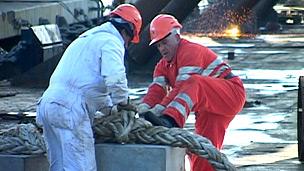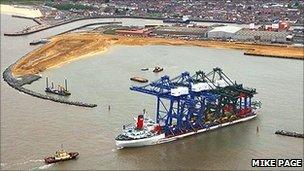Great Yarmouth's harbour cranes prepared for Italy
- Published
They should have handled cargoes from Europe and beyond.
But the downturn in container freight traffic has meant that the giant cranes at Great Yarmouth's outer harbour have been imported, only to be exported again this weekend without ever being used.
When the economy was still buoyant, the Port of Singapore Authority (PSA) invested £30m to buy and install the cranes on the quayside.
But by the time they were commissioned into service in May 2010, the shipping industry was in the doldrums.
PSA - which had invested in the new harbour in a joint venture with EastPort UK's parent company - struggled to find work for Britain's newest container terminal.
In November 2010, EastPort announced it had suspended operations at the terminal and that the cranes would leave town, with a new focus on the offshore renewable energy industry.
The cranes are now on a barge ready to be towed to Italy - and once adjustments are made PSA will install them to replace older models at the Port of Venice.
Collapsed deal
To say the cranes never found work is not quite accurate. One contract emerged, but it was scuppered for reasons that still have not been made public.
The global freight handler Panalpina had a contract to move a cargo of power station components to Mauritania in October 2010.
With some containers at the port ready to be loaded, the ship was turned away and the deal fell through.

Yarmouth's cranes will replace the aging ones in Venice
Speaking in October, Mark Woodhouse, of Panalpina, said he did not know why the deal collapsed at the last minute.
"I had an indirect call asking us to take our equipment out of the port because they did not feel they could do the job," said Mr Woodhouse.
"We had already delivered equipment to the outer harbour, so we had to redirect that down to Ipswich."
So without working, the cranes are set to relocate.
Public finances
EastPort UK's chief executive Eddie Freeman said: "I can understand from an external point of view people being disappointed and not understanding the whole story.
"But we've maintained right from the beginning it's been a feature of an economic environment that none of us could foresee.
"If there comes a time when it's viable to bring gantry cranes back and do short-sea containers we'll consider that."
With public finances going into the building of the outer harbour, following the cranes' redundancy EastPort UK quickly came under fire from local people wanting to know whether their money had been wasted.
This was something that Mr Freeman was keen to stress was not the case.
"Public funding went into the breakwater and the infrastructure - nothing to do with the cranes or the infrastructure for the cranes to operate on," he said.
"That was borne very much by the private sector - primarily PSA."
Offshore energy
In the space vacated by PSA's cranes, two offshore energy firms are set to move in.
SeaJacks UK - a Gorleston-based company that operates jack-up vessels for offshore energy installation construction and support - has its newest vessel Leviathan at the port.

The cranes arrived by sea in May 2009
"The outer harbour has been seen as a great advantage for us," said SeaJacks' chief executive Blair Anslie.
"For our vessels we need deep water access and the inner harbour is restrictive because of the sharp bend.
"There are other harbours we can access on the east coast that we could go to, but we are a Yarmouth-based company and we like to support our local businesses."
In the EastPort offices hangs a photograph of the 235m (771ft) ship that brought the cranes from China to Great Yarmouth. Mr Freeman said the picture will not be taken down after the cranes depart.
"It was a moment in time and I personally enjoyed the moment in time very much," he said.
"One door closes another one opens. I'm optimistic about the future."
- Published9 November 2010
- Published28 July 2010